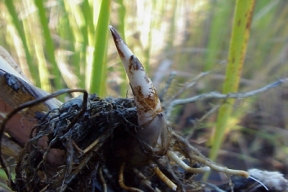Small changes make a big difference

Typha latifolia has developed many ways to succeed in the wetland habitat. The plant grows very tall and fast. Some plants can grow over 6 feet tall! The stems are usually simple branched and erect . This allows for the plant to rise above other wetland plants for more sunlight. The leaves are usually twisted, which can then catch water and allow it to run down the stem to the roots. The leaves are also thick and spongy to absorb as much water as possible.
 The roots are very shallow and are attached to rhizomes.
Rhizomes are a thick horizontal stem that the roots grow out of. The
rhizomes develop shoots that eventually grow into new plants. The
rhizomes of T. latifolia are very extensive and coarse. They
are soft and spongy with many air spaces to allow for more nutrients
from the soil. This allows the plant to persist through drought
conditions and be dormant through the winter!
The roots are very shallow and are attached to rhizomes.
Rhizomes are a thick horizontal stem that the roots grow out of. The
rhizomes develop shoots that eventually grow into new plants. The
rhizomes of T. latifolia are very extensive and coarse. They
are soft and spongy with many air spaces to allow for more nutrients
from the soil. This allows the plant to persist through drought
conditions and be dormant through the winter!
rhizomes and roots

Typha latifolia is monoecious, which means that each stem contains a male and a female part. This plant has developed a system to become fertilized and spread its seeds extensively! The plant makes a “seed bank” underneath them in the soil to allow for rapid colonization. This “seed bank” is so persistent that it allows growth as early as one year following a disturbance! Throughout the winter the seeds stay attached to the spikes. When spring comes, the seeds are then dispersed. With the extra water in spring, the fruits have special hairs at the base that allow them to float on top of water and also blow in the wind. When the fruit hits the water, it breaks open dispersing seeds.
To learn more about how the cattail eats, click here.
Back to the marsh
